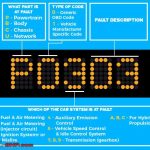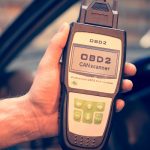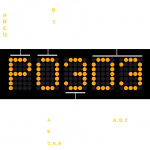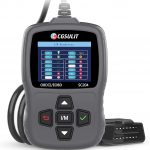
In this article we’ll cover how to read check engine codes and the meaning behind each. We’ll look at P – Powertrain, B – Body, C – Chassis, and U – Undefined. Once you understand what each letter means, you’ll know how to diagnose a vehicle’s issues and make an informed decision regarding the repair. We’ll also cover why P stands for “Powertrain” and how you can identify the cause of the code.
P – Powertrain
Each OBDII code is associated with a specific component in your car. The first letter of the code stands for powertrain, which refers to the engine, transmission, and any related accessories. There are also three letters that follow: U, C, and P. The letters P, C, and U-codes are reserved for the car’s engine, transmission, drivetrain, and powertrain. The first letter of each code is an acronym, and the second letter is a manufacturer-specific code.
The next letter represents the problem area. This error code will be accompanied by the symptoms listed above. It indicates that the car is experiencing a problem with the powertrain. The vehicle’s body may also be affected. A malfunction in the EVAP system could be causing the error code to appear. If you encounter this code, the first step to fixing the problem is to contact your car manufacturer for help. If you’ve tried several fixes without success, then you probably have an issue with the drivetrain.
In addition to P, U, and C codes, you can also see DTC codes on the instrument panel. They identify the problem and can be easily read with a DTC tool. A DTC code can be found through a warning light on the instrument panel. The code is grouped into categories such as P – Powertrain, B – Body, and U – Network and vehicle integration. The P, Powertrain, B, and C codes identify problems with the engine, transmission, or brakes, and C – Chassis.
B – Body
Check engine codes are divided into three categories: powertrain, chassis, and body. Powertrain codes relate to the engine and associated mechanical systems. Chassis and body codes relate to other components of the car, such as the exhaust system. The second category, network & vehicle integration, covers computer systems shared by various manufacturers. Trouble codes start with a “P” letter, and the first digit tells whether the code is generic or specific to a particular manufacturer.
Depending on which system your car has, B – Body codes can be confusing. The first one is a generic code, while the second is specific to your car model. In order to understand the code better, you should consult your owner’s manual or vehicle manufacturer. These manuals often come with explanations for the different codes. But, you can simplify the process of understanding the B – Body of check engine codes by using easy-to-use tools.
The B – Body of check engine codes is a symptom of a bigger problem. This code can be a sign of an issue with the evaporation system or fuel pump. The oxygen sensor is connected to the fuel tank and may malfunction, resulting in lower fuel economy or an air/fuel ratio issue. The evaporation system is made up of vent hoses, a charcoal canister, and a pressure or vacuum sensor.
The OBD code itself contains five characters. The first two letters specify the code type and the second letter indicates the vehicle system. The third character provides more information and a detailed diagnosis. The code is used to troubleshoot various problems in your vehicle. If you have the code on your car’s computer, you should consult a mechanic and repair shop. This way, you will know exactly what to do and what to avoid.
C – Chassis
C – Chassis check engine codes are generated for problems in various car systems. These codes are used when there is a problem with one of the major components of your vehicle, such as your steering or suspension. The problem can be related to one of several areas of the car, including the brakes and airbags. The code could also be caused by a fault in the power steering control module. To find out what is causing the C – Chassis check engine codes, you must first understand what these codes mean.
These codes come in different formats. Some have generic codes, while others are manufacturer specific. Some codes are listed below. You can search for the codes using a scan tool. In addition, the codes include a letter prefix followed by four numbers. The first two digits of each code indicate the type of problem, while the third digit indicates the particular system that the problem affects. A C – Chassis check engine code is useful for troubleshooting your car.
BMW abbreviates its engine codes. For example, “N52N” is used in BMW documents. The other codes – N52B30M0 and N52K30M0 – are more logical. However, “N52N” is just shorthand for a Technical Update. N52N stands for “Technical Update” and TU means “new engineering feature”.
A C – Chassis code indicates that a specific component in your car is malfunctioning. For example, a malfunctioning oxygen sensor may trigger this code. A malfunctioning oxygen sensor may cause poor fuel economy. The problem may also affect the air/fuel ratio. If a malfunction in this part of the car causes the code, consult a mechanic to fix the problem. You may need to replace the catalytic converter or adjust other parts of your engine.
U – Undefined
What does U – Undefined mean in check engine codes? The U – Undefined is a type of object, where the value is “null”. In other words, it means that the value is not defined, or if it does, it returns null. The same concept applies to null references in check engine codes. This code breaking scenario occurs when a function tests a member on a null variable, but the undefined value is actually the same thing. This code breaking scenario occurs because the programmers’ philosophy is to code for weaknesses and idiosyncrasies of their language rather than their own common behavior.
Understanding the composition of each DTC can help you troubleshoot it easily. The first character in the DTC is the system in which the error occurred, while the second character identifies the code type. The same goes for the U – Undefined code, which can be a minor issue or a major one. If your car is showing this code, it may be time to visit a mechanic.
The U – Undefined code may also mean that your engine coolant temperature is below the thermostat that regulates it. This isn’t a specific manufacturer’s code, but rather a standardized code that can be interpreted according to SAE definitions. A malfunction in the fuel and air metering subsystem may be causing the code to appear. If your car displays this code, you may want to take it to a mechanic as soon as possible.
There are three categories of codes. The first two are manufacturer-specific, while the third one covers areas that are not related to emissions. The P – Powertrain code refers to the engine and transmission, as well as the fuel and ignition system. The third code is called U – Undefined and isn’t related to emissions. The U – Undefined code, meanwhile, covers other aspects of the vehicle.
P – Body
There are two types of P – Body check engine codes: generic and standard. The former refers to the check engine light and is set off by a malfunction in the vehicle’s emissions system. The latter refers to a problem in the car’s engine, transmission, or air/fuel ratio. P – Body codes are specific to a particular type of vehicle and are not universally applicable to all vehicles.
If you get a “P” code, the issue is related to the powertrain system. If the code is “B,” the problem is with the body system. The car might have a problem with the airbags or the anti-lock brakes, for example. If the P code is displayed, there are other problems with the vehicle’s transmission or body. If you see “C” instead of “P,” your car probably has a wiring problem, or a sensor failure.
The P – Body check engine codes are grouped according to their manufacturer. The first digit refers to a generic code. The second digit, if any, is a manufacturer-specific code. When the second digit is a generic code, it refers to a vehicle problem with the powertrain. The third digit, if present, indicates a specific vehicle problem. These codes indicate the need for a technician to repair or replace the engine, transmission, or fuel system.






